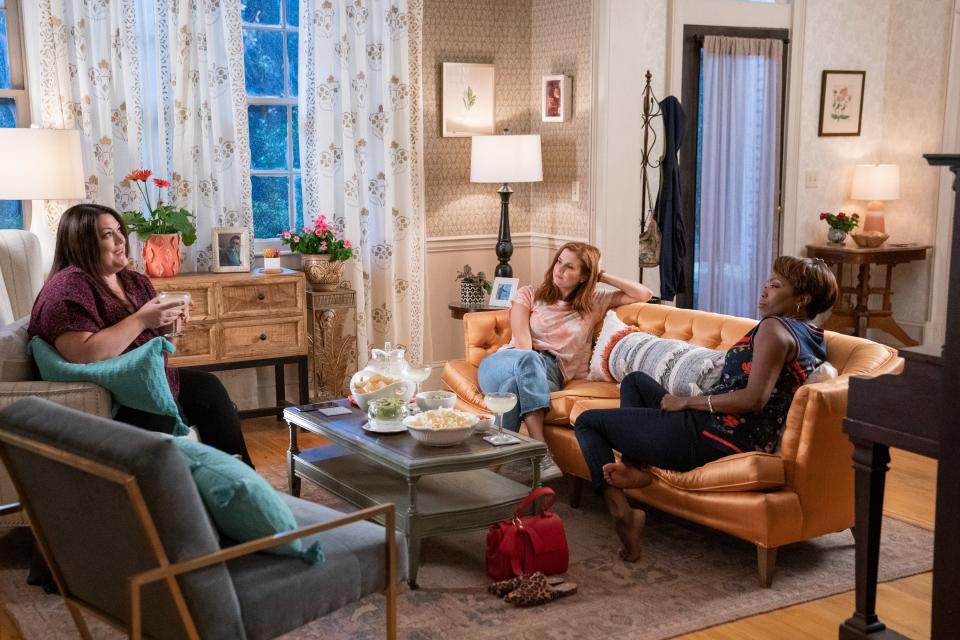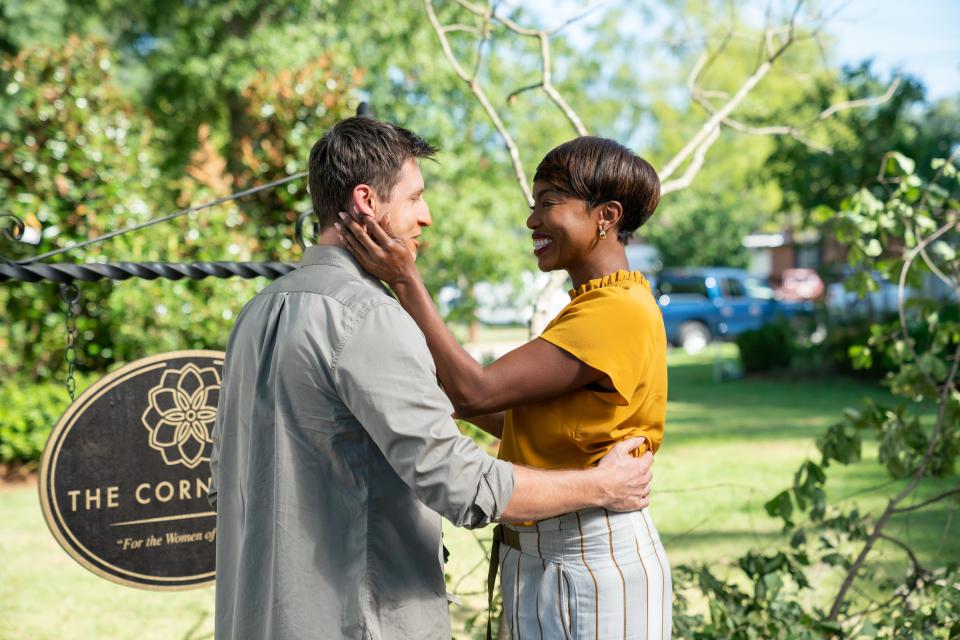How Netflix’s Sweet Magnolias Became the Surprise Hit of the Summer
Five days after Netflix premiered Sweet Magnolias, executive producer and showrunner Sheryl J. Anderson thought she was seeing things. There, in big white letters on her Netflix home screen, was the streaming service's list of top 10 shows in the United States. And at number one? Sweet Magnolias, a feel-good series starring JoAnna Garcia Swisher, Brooke Elliott, and Heather Headley as lifelong friends in a small Southern town.
“I thought it had to have been some mistake when I saw it was trending,” Anderson tells Glamour. The romance-drama was adapted from Sherryl Woods’s hit novels of the same name, but she didn't expect the series version to take off that quickly. “I checked eight different places, and then I had my tech-savvy kids check too. I thought we would be a slow-burn, word-of-mouth show, so the fact that we bolted out of the gate like thoroughbreds...I still am trying to wrap my head around that.”
While Netflix rarely provides ratings or numbers for any of its original series, reaching the coveted top-10 list is the easiest way to measure success. Anderson jokes that because of the worldwide support for Sweet Magnolias, her daughter is learning how to say, “Who’s in the car?”—a nod to the season one cliff-hanger—in various languages.
The collective love for the show hasn’t been lost on the cast either. All three leads—Garcia Swisher, Elliott, and Headley—are industry veterans and used to the constant uncertainty of their chosen profession. So seeing Buzzfeed quizzes asking things like, “Who Is Your Sweet Magnolias Soulmate?” feels as satisfying as, say, one of Coach Cal’s romantic gestures.
“It was a surprise to all of us,” Garcia Swisher says over a Zoom chat with her costars about Sweet Magnolias' instant impact. “I stopped focusing on the outcome long ago. I was like, Let’s just have fun making it. In fact, I called up [co–executive producer and director] Norman Buckley after my first day and said, ‘If this show can capture what I felt today with those two ladies, the world is a better place for it.’”
Even so, “I was hopeful the show would resonate," she says, "but I didn’t expect this.”
Called “as refreshing as a glass of sweet tea on a hot Southern day,” “a romantic hit,” and “a sweet escape,” the series has resonated with fans who enjoy following along as Maddie Townsend (Garcia Swisher), Dana Sue Sullivan (Elliott), and Helen Decatur (Headley) juggle family, careers, and hot men in the picturesque town of Serenity.
Fans have even started including some of the characters' traditions into their own lives. “I don’t drink, but so many women have written to me to say, ‘I’m having Magnolia nights, or sweet-tea nights,’” Headley says of the characters' beloved margarita-fueled friend dates. “Even over Zoom, women are getting together to shoot the breeze and find out how everyone is really doing. How great is that—that we as women can get together and hold each other up?”
Putting women together in the same room for food and drinks isn’t revolutionary, of course. From The Golden Girls and cheesecake to Sex and the City and cosmopolitans, TV has a long tradition of using these kinds of gatherings to speed up honest heart-to-heart conversations among friends. Audiences respond because we all want to feel like we're part of the group—it's a safe space where women can unload about the stressors of their lives like financial burdens or unfulfilled relationships.

Sweet-Magnolias-Brooke-Elliott-JoAnna-Garcia-Swisher-Heather-Headley-margarita-nights-season-1.jpg
Eliza Morse/Netflix“I want the viewer to feel like the fourth Magnolia,” Anderson says. “Early on in the writers room, I said, ‘We want everyone to see themselves in Serenity. We want you to want to hang out with them, to want to have coffee with these people at The Corner Café, and then over to Sullivan’s for dinner, and then somebody’s house for dessert.”
For Garcia Swisher, that's what makes the series so special. “To actually do a show that celebrates togetherness and what it means to survive and endure—and be loved for exactly who you are—that’s everything,” she says. “These women don’t go through life alone because they have each other.”
And because viewers are so invested in the characters' lives, Anderson believes, it's especially important to show how deep their bond goes. The women—presumably all in their early to mid-40s—are all incredibly busy, but they still show up for each other. “I think one of the things that’s resonating with women of the same age as these characters is that we’ve all got kids and businesses and responsibilities, but we don’t make the time we should for sitting down with each other and lifting each other up,” Anderson says. “The fact that these women—with all that’s going on—make it a point to spend time together is very important.”

Sweet-Magnolias-Heather-Headley-Helen-Decatur-Ryan-season-1.jpg
Eliza Morse/NetflixBut it was also important that the characters' struggles don't disappear after one margarita night. “I love that the show represents women in accurate ways,” Elliott says. “Women go through things; they’re angry, they’re impatient, they’re fun, they’re happy. They are human beings. We shouldn’t have to worry about being likable enough. It’s so important to be real and portray a woman who gets to be all of what a woman is.”
While some critics wrote the series off as a “syrupy watch” or a “Hallmark holiday movie,” they perhaps overlooked the ways the show was anything but. Sure, the town could be straight out of a Pottery Barn catalog, but it’s also refreshingly inclusive and diverse—still, unfortunately, a rarity on television. Plus, there's storylines about sex—hot, steamy sex—drinking, and mental health. No offense to Hallmark, but when is the last time you saw any of that in its movies?
Headley says she appreciated the inclusion and diversity of Sweet Magnolias—both in front of and behind the camera—while she was filming, but the events of the past two weeks made her appreciation for the show grow so much she even called Anderson recently to thank her. The fact that the series didn't have to make any changes in response to the Black Lives Matter uprising, because inclusion was already there, speaks to the importance of the show, she explains.
“Everyone was represented: There’s a gay couple, an interracial couple, men and women of all ages,” she adds. "Sheryl always says we all want to live in Serenity, that we all see ourselves in Serenity. In the past two weeks, I realized, yes, that is exactly it.”
Anderson says she cried after her conversation with Headley. “None of us could have imagined where the world would be when this show premiered, starting with the pandemic and then the horrible murders and the protests that followed," Anderson says. “I was pleased at the world we had all built together and that Heather put it in those terms. We didn’t do this as a statement. I started working on the show two years ago, and one of the first things I said is ‘I want Serenity to be a diverse community in every meaning of the word because I don’t think there are enough communities like that on television.’”
For Anderson, that started with the writers room—there are six writers, five of whom are women and two of whom are Black—and hiring several female department heads. (The production supervisor, production designer, set designer, costume designer, and two out of three directors are all women.) Then came the cast. “I wanted not just racial diversity, but age and body type diversity because I wanted it to look like a real town," Anderson says. She also instructed the extras casting director to make sure all background and principal actors reflected the real world, including parts for performers with Down syndrome and prosthetic limbs.
Anderson also made sure that all Black actors had Black hair and makeup artists so, as she says, “people felt safe and heard and respected.” As a result, “we were working not only with the best of the best, but with people who were working from a place of joy, who enjoyed the inclusivity of both the community we were working in and showing the world.”
“The whole environment was celebratory and honest," says Garcia Swisher, who was born to a Cuban father and Spanish American mother. "There was this richness, this texture, and this love that was just beautiful.”
With all that said, Anderson knows even more work still needs to be done. “If we’ve helped by being one of those shows that encourages inclusivity, then I’m absolutely delighted," she says. "Still, I’d love the opportunity to do more and go further.”
Which raises the question: Will there be the opportunity to do so with a season two? If it’s up to Anderson and the actors, the answer is a resounding yes. Now it’s just up to Netflix. “Our executives at Netflix are incredible and supportive. I want them to make a full and well-considered decision as long as that decision is yes,” Anderson says with a laugh.
For now, everyone is taking pride in the impact they've made so far. “It’s an exceptional blessing that we were able to offer comfort and joy at a time when people needed it so badly,” Anderson says. “I just pray that we get to do it again.”
Jessica Radloff is the Glamour West Coast editor. You can follow her on Instagram (and see a special Sweet Magnolias reunion photo) here.
Originally Appeared on Glamour

